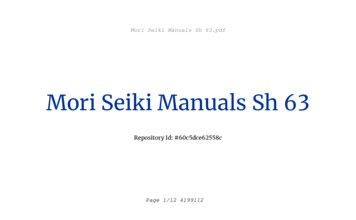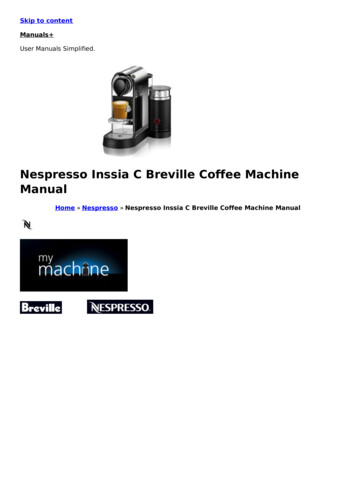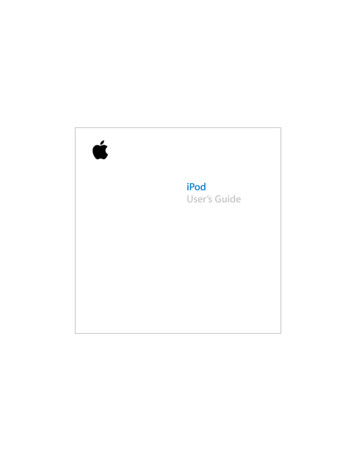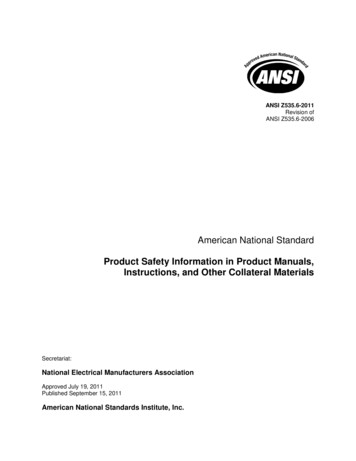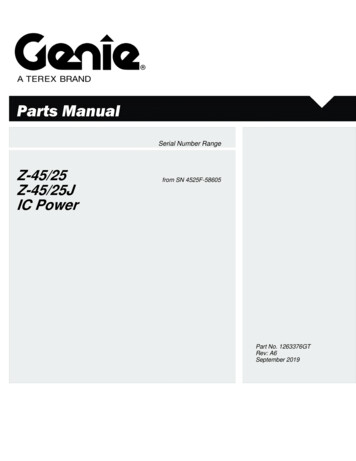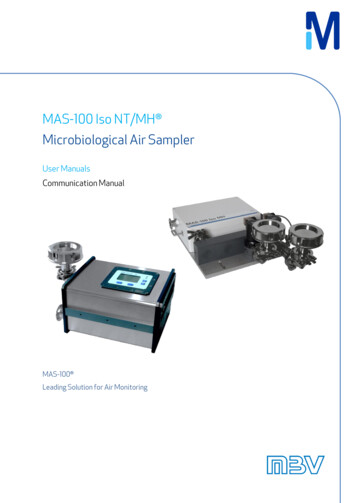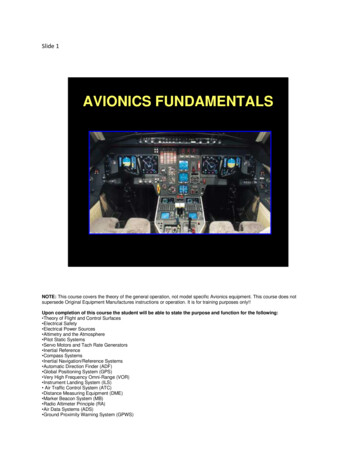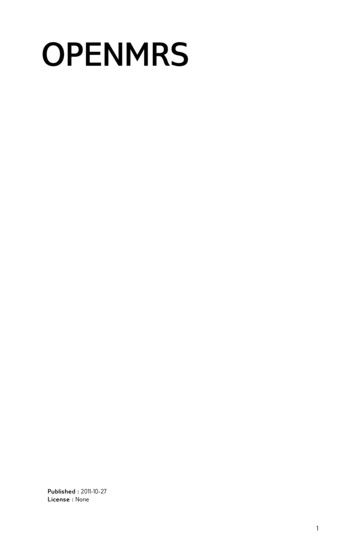
Transcription
OPENMRSPublished : 2011-10-27License : None1
INTRODUCTION1. OPENMRS AROUND THE WORLD2. A BRIEF HISTORY3. EXAMPLE: AMANI CLINIC2
1. OPENMRS AROUND THE WORLDOpenMRS clinical and research locations as of 2011.OpenMRS is an electronic medical record system (EMR), designed for use in the developingworld and first established in 2004. T oday, the system has evolved into a medical informaticsplatform used on every continent, supporting health care delivery and research in an extremelywide variety of contexts.Our world continues to be ravaged by pandemics of epic proportions, as untold millions ofpeople are infected with diseases such as HIV/AIDS, multi-drug resistant tuberculosis, malaria,and many others. Many of these infections occur in developing countries, where lack ofeducation and resources contribute to scores of preventable deaths. Prevention and treatmentinterventions on this scale require efficient information management, which is particularlycritical as clinical care must increasingly be entrusted to less skilled providers. Whether for lackof time, lack of money, or no access to software developers, most health care programs indeveloping countries manage their information with simple spreadsheets or small, poorlydesigned databases--if they have any electronic infrastructure at all. Most health care recordsin the developing world are still maintained on paper.As a response to these challenges in developing countries, OpenMRS was created as a medicalrecord platform--a rising tide which we hope will lift all ships. It is designed to offer a bettertool for information management, but also to reduce unnecessary, duplicate efforts. In theyears since its inception, the OpenMRS community has grown from a handful of organizationsto a massive collaborative effort by both groups and individuals, all focused on creatingmedical record systems and a corresponding implementation network that allows self-reliancein system development, even in resource-constrained environments.Since its beginning, OpenMRS has been based on the principles of openness and of sharingideas, software and strategies for deployment and use. T he system is designed to be usable invery resource-poor environments and can be modified with the addition of new data items,forms and reports without the need to write complicated application code. It is intended as aplatform that organizations can adopt and modify, avoiding the need to develop a systemfrom scratch.And indeed, organizations around the world are doing just that. OpenMRS is now in use inclinics in Argentina, Botswana, Cambodia, Congo, Ethiopia, Gabon, Ghana, Haiti, Honduras, India,Indonesia, Kenya, Lesotho, Malawi, Malaysia, Mali, Mozambique, Nepal, Nicaragua, Nigeria,Pakistan, Peru, Philippines, Rwanda, Senegal, South Africa, Sri Lanka, T anzania, T he Gambia,Uganda, United States, Zanzibar, Zimbabwe, and many other places. T his work is supported bymany individuals and organizations, including international and government aid groups, NGOs,and for-profit and non-profit corporations.3
OpenMRS is not only in use in many different places, but it is also being used to meet manydifferent needs. In Kenya, it is used to support health care delivery for hundreds of thousandsof patients at a network of over 50 clinics--some connected by typical networks, but manywhere the connection requires offline synchronization to external storage that can bephysically transported between sites! Another NGO uses a central OpenMRS server connectedto clinics in multiple countries via satellite Internet connections. In Malawi, creative individualswith a talent for technology have created a mobile cart running OpenMRS that physicians rollaround their clinic, interacting with the system using a touchscreen. In Rwanda, the nationalministry of health has worked to roll out a connected national health care system usingOpenMRS. In the United States, OpenMRS is used to track patients at large sporting events, formobile providers of health care to homeless people, and as a personal health record thatallows cancer patients to share treatment and home health care information with caregiversand family members.OpenMRS in use at TRAC Plus Clinic in Kigali, Rwanda.In the last several years, use of mobile technology has increased dramatically, particularly in thedeveloping world. In some developing countries, there are more mobile phones than people!Facilitated by other open source projects, OpenMRS can be integrated with SMS messaging,allowing community health workers to add information about adherence to medicationregimens to a patient's record, as they make rounds through villages in rural Africa. Elsewhere,mobile phone applications are used to guide these community volunteers in home-based HIVtesting and counseling, enrolling prospective patients from the comfort of their own homes.Besides clinical care, the platform can also be used in research settings. In the United States,OpenMRS has been used both in training medical informatics students, as well as in conductingvarious research projects in the fields of public health. In Peru OpenMRS is used as the researchdatabase for a large study of drug resistant tuberculosis funded by the US National Institutesof Health. Because the system has been designed as an extensible platform, it is very easy forresearchers to adapt OpenMRS to do what they need.4
2. A BRIEF HISTORYOne of OpenMRS's birthplaces--Moi University Teaching and Referral Hospital, Eldoret, Kenya (2004)T hroughout the 1990s, an academic partnership flourished between Indiana University Schoolof Medicine in the United States and Moi University in Eldoret, Kenya, providing Kenyan medicalstudents with access to health care training. T his program continued to grow for several yearsuntil a severe outbreak of HIV/AIDS in Western Kenya caused the program to rethink its goals,at which point the Academic Model for Prevention and T reatment of HIV/AIDS (AMPAT H) wascreated. T he number of patients in Kenya continued to grow, and basic IT systems includingMicrosoft Access were used to monitor patient care.In February 2004, the amount of data had become too large for AMPAT H's existing systems,so their medical director invited Burke Mamlin, from the Regenstrief Institute in Indianapolis,United States, to visit the site and evaluate how improvements in medical informaticstechnology could improve AMPAT H's data management. Regenstrief had long been recognizedas a leader in medical informatics research, and Burke brought his colleague Paul Biondich alongwith him on the visit to Kenya. It quickly became apparent that a new system was needed. Pauland Burke began to design the data model for a new medical record system for AMPAT H,which would go on to become OpenMRS.At the same time, a Boston-based non-profit named Partners In Health (PIH) was pioneeringthe use of web-based EMRs in developing countries. T hey had built the PIH-EMR, which theywere using to support the treatment of multi-drug resistent tuberculosis in Peru, and HIV inHaiti. But Hamish Fraser, PIH's director of the EMR project, was worried: PIH was about toexpand into Rwanda, Lesotho, and Malawi, and he feared it would be difficult to maintain theirhome-built system in 5 countries.In September 2004, Paul and Burke met Hamish at the World Congress on Medical and HealthInformatics (MedInfo) conference in San Francisco. It became apparent that the three sharedsimilar goals and needs, so they agreed to work collaboratively to develop a system thatwould be suitable for the various needs of humanitarian work in African nations and beyond.5
Paul and Burke hired developer Ben Wolfe to begin work on programming an early prototypeof OpenMRS, based on their previous work at AMPAT H and Regenstrief. Several months later,PIH's lead developer Darius Jazayeri joined the project, merging PIH-EMR's functionality into thenew system. T he previous systems at AMPAT H focused on data entry, while at PIH, the focuswas more on clinical workflow. T he new system combined features of both the AMPAT H andPIH systems.Because of the strong cooperation between PIH and Regenstrief and the long distancesinvolved, it became clear that an open source software model of development was the bestway to sustain and grow the platform, and the OpenMRS project was born.While the collaboration between Regenstrief and PIH continued and the new system was beingdesigned, the groups were looking for additional support in Africa. T hey turned to theircolleague Chris Seebregts, from the South African Medical Research Council (MRC). Chris wasalready heavily involved in the field of medical informatics throughout sub-Saharan Africa, andbrought with him a wealth of knowledge about the needs of informaticsimplementations. Seebregts had been adapting OpenMRS for use in South Africa and startedto build up a community of implementers of the software around the world. His work led tomassive growth of the OpenMRS community (now nearly 2,000 strong as of late 2011). InFebruary 2006, AMPAT H launched OpenMRS in Kenya, and PIH brought it to Rwinkwavu,Rwanda, in August of the same year. T he South African MRC first switched on the system atRichmond Hospital in KwaZulu-Natal at the end of 2006.As both the OpenMRS application and open source community grew, they gathered theattention of many other large projects and agencies. Some of these have extended bothfinancial and consulting support over the past several years, including:T he United States Center for Disease Control (CDC)Canada's International Development Research Centre (IDRC)National Institutes of Health Fogarty International CentreT he Millennium Villages Project of the Earth Institute, Columbia UniversityT he Rockefeller FoundationWorld Health OrganizationIn an effort to broaden participation in the project around the world, OpenMRS beganparticipating in the Google Summer of Code (GSoC) program in 2007 . GSoC providesuniversity students who wish to participate in open source development projects with astipend and a close mentoring relationship with an experienced project team member.Participation in the program has continued since then--OpenMRS is now one of the larger opensource projects in the program, boasting a large class of alumni, a number of whom continueto contribute to the project. Many of these alumni come from the developing world, and somehave gone on to successful software development careers.6
Any early gathering of OpenMRS implementers and developers in Cape Town, South Africa.One of the aims of the OpenMRS community is to help build local capacity in the places whereit is used. T o that end, participants in the community are encouraged to develop programsand processes that encourage entrepreneurship and the creation of partnerships to grow thefield of medical informatics, particularly in the developing world. For example, in Kigali, Rwanda,Partners In Health jump-started a local training program known as E-Health SoftwareDevelopment and Implementation (EHSDI). T his 9-month course conducted in partnership withthe Rwanda Development Board and the Kigali Institute of Science and T echnology (KIST ) wasdesigned to teach students to develop medical information systems. It includes extensivetraining in using the OpenMRS platform.T he number of individual and organizational volunteers who participate in the OpenMRScommunity has continued to grow, tripling in size between 2010 and 2011. T hese individualsparticipate in various ways, from documentation and bug reports, from training and providingsupport to other community members. T he release of OpenMRS 1.8 was made possible by theassistance of over 50 contributors.Further, collaborations with other open source software organizations such as Open Data Kitand Pentaho have produced volunteer contributions to OpenMRS, and commercial consultingorganizations such as T houghtWorks Inc. have contributed many hours to developing andimproving OpenMRS.At the close of 2011, the OpenMRS community is preparing to launch an independent not-forprofit organization to help support the project's needs as it grows. T he goal of thisorganization will be to provide technical infrastructure and community management, to assistcollaboration and cooperation of project volunteers throughout the world, and to providetraining and support to those who seek to implement OpenMRS as a key part of a medicalinformatics strategy in clinics, hospitals, and government health organizations.From its humble beginnings as a solution to a problem in a small African town, OpenMRS hasbecome the largest open source health care project on the planet. Between 2006 and 2011,OpenMRS at AMPAT H in Kenya has recorded over 111,000,000 points of data for over 180,000patients, helping to save many thousands of lives. Every day, similar stories are retoldsomewhere else around the world with the assistance of thousands of volunteers. T heOpenMRS community continues to grow, and we are excited that you're interesting in joining us.Regardless of your background or interests, there is a way for you to both contribute and gainfrom the work of others in the OpenMRS community.7
3. EXAMPLE: AMANI CLINICWe assume if you're reading this book that you're interested indeploying OpenMRS to support clinical care in the real world. T o bridgethe divide between theory and practice, and to illustrate the sometimeschallenging process of deploying a large health-care information system,we have used the example of the fictional Amani Clinic as a case studythroughout this book.Every time you see this image in the book, you will learn how AmaniClinic used the information discussed to plan and implement OpenMRS.While a single example could never possibly capture all the complexity of the many differentcontexts in which OpenMRS might be used, we hope it will serve as inspiration to think abouthow your environment may be similar or different. We also hope that as you read, you
Participation in the program has continued since then--OpenMRS is now one of the larger open source projects in the program, boasting a large class of alumni, a number of whom continue to contribute to the project. Many of these alumni come from the developing world, and some have gone on to successful software development careers. 6




